Human Flower Project
Sunday, July 15, 2007
Talking Flowers to the Men of Cork
Moved by the EarthScholars’ recent article on men’s taste in flowers (or lack thereof), Dara Burke of Cork, Ireland, headed out to do some man-in-the-mall interviews herself. We commend you, Dara, for going to the source. Many thanks for sharing your findings here at HFP!
 Picking up flowers
Picking up flowers
at Douglas Court
in Cork, Ireland
Photo: Dara Burke
By .(JavaScript must be enabled to view this email address)
Did you know that 7 out of 10 purchasers of cut flowers are women? Sound about right? Did you know also that men spend up to 16% more on flowers per purchase? That means that if only 1 out of 7 women sent their male friend or partner to the store to buy flowers instead of going themselves, the cut flower market earnings would jump almost 2%. That’s almost one year’s growth in the cut flower market overnight!
So the tough question that remains is why don’t more men buy flowers more often? Not finding any data on the flower purchasing patterns of men, I made my own unscientific survey. On Thursday, June 28, I went to my local supermarket, Douglas Court, to ask questions. Douglas is a fairly upper-middle class suburb of Ireland’s “second city,” Cork. With a population of around 300,000, Cork lies on Ireland’s southeast coast, at the world’s second largest natural harbor.
I spoke with 30 male flower purchasers, most of them between the ages of 18 and 60. Here’s what we learned, with some thoughts as to what their answers could mean for the cut-flower industry as a whole.
* Men don’t purchase flowers regularly
Men really don’t buy flowers as often as they should. Almost 90% of respondents only purchased flowers once every six months to a year. That’s a lot of missed Valentine’s Days, Wedding Anniversaries, and Birthdays every year, we think!
* Men buy mostly for occasions
Asked when they do buy flowers, men seem to be mostly occasion-buyers. 64% listed birthdays as a flower-buying occasion, 50% listed Anniversaries, 23% listed National Holidays. 30% were impulse purchasers and only 12% said “other.” (We’re wondering whether 30% is what we like to call the guilty-conscience ratio….)
* Men prefer buying from florists but most don’t have a regular florist whom they frequent
87% of men said that they don’t have a regular florist yet the same number of men (87%) listed florist as their preferred place to buy flowers. 30% said that they purchase flowers in the supermarket also. 3% said they purchased flowers in a convenience store, 3% listed garden centres and 3% listed “other.”
Although men don’t purchase flowers very regularly, generally they seemed to like to ‘do it properly’ when it comes time to buy that special bouquet for their loved ones. Men will spend more, and they’ll go to a florist because they believe they will get better quality.
* Men don’t buy flowers more often because …
Asked to list two main reasons why they don’t buy more flowers, 77% of men responded that they prefer to buy other gifts, 47% said that flowers are too expensive, 40% listed forgetfulness as one of their reasons, and 14% said that they were too busy.
These figures seem to suggest that a reminder service may be a good way to connect with male flower-purchasers. Selling other items besides flowers may also have a positive effect, although it’s likely that men would buy these other gifts from a non-florist store. A delivery service could also be a boost for the 14% of men who are too busy.
* Men would like to be reminded of flower giving occasions
67% of men said that they’d respond positively to a flower reminder service offered by their florist. Of those who responded that they would like to get a reminder, 57% said they’d prefer an Email reminder, while 43% said they’d prefer a text message reminder to their mobile phone. 3% listed both.
* Flowers are an appropriate gift for a man (sort of…)
Asked whether they felt that flowers were an appropriate gift for a man – 47% of our men said “yes,” although many of them qualified that statement by saying that they’d pass the flowers on to their mum, wives or girlfriends.
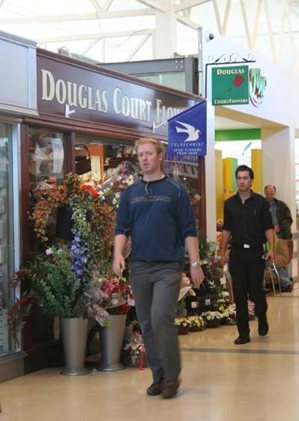 Men at Douglas Court
Men at Douglas Court
said that they preferred
buying flowers from a florist
Photo: Dara Burke
The men who responded to our survey were a fairly diverse group—everyone from business professionals stopping off for a pint of milk on their way home from work to teenage custodial staff working on the shopping center floor. Since the days of the ‘Celtic Tiger’ and the buoyant Irish economy, Ireland’s inhabitants have become increasingly ethnically diverse, so there was a good cross-section of cultures there also – including at least one Indian, one Scottish respondent and one Nigerian.
It took me a little over 2 hours to gather the data from 30 men. There’s a broad cross-section of society at a shopping center between the hours of 4-6.30PM, so I’d expect the results to be the same anywhere in the country. Indeed, I’d expect the results to be similar anywhere in the UK also, with probably a degree of similarity the US as well.
I think maybe on continental Europe and in India, the results might differ slightly. I spoke with two guest workers from India and they generally seemed to be more enthusiastic about receiving flowers as a gift than most of the Irish males.
Overall there seems to be good growth potential in the flower market from and for males. Men are generally occasion-buyers and have a strong preference for florists when they do purchase, although most don’t seem to have do business regularly with any florist in particular. Reminder services and perhaps home deliveries are good ways to bridge the male flower gap, with a possibility that cross-selling gift items may yield good results.
Note: .(JavaScript must be enabled to view this email address) operates, FlowerHour.biz, based in Cork, Ireland, a florist marketing company that keeps florists in touch with their customers by email and text-message reminders for important events.
Friday, July 13, 2007
Botanical Gentry, Make Room for Pokeweed
As the unruly “salat” maker vies for space in her garden, horticulturist and garden designer Jill Nokes puts in a good word for a disparaged plant. Jill, we and the mockingbirds thank you!
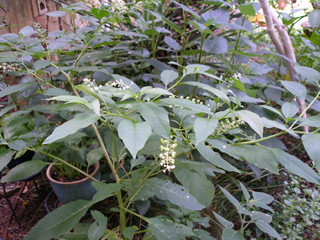
Pokeweed in flower, Austin, TX, July 2007
Photo: Jill Nokes
By Jill Nokes
Around here, the summer of ’07 will surely be remembered for freakishly abundant rainfall. It’s already mid-July, yet my garden looks more like Vietnam’s Mekong Delta than Central Texas. But after two years of scary drought conditions, I’m not complaining. Even ordinary plants are super-sized and showing off, hoping to get a full-time gig in the permanent display. I’m especially enjoying a bumper crop of pokeweed (Phytolacca Americana var. Americana).
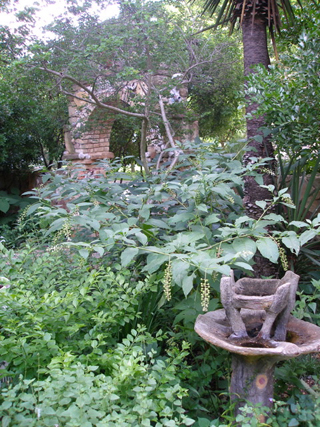 Pokeweed
Pokeweed
Phytolacca Americana var. Americana
Photo: Jill Nokes
Pokeberry and elderberry are among the plants that fall into the red-headed stepchild category: they are interesting, and even useful, but for most people they are just too unruly or free-spirited to mingle well with the botanical gentry. Horticultural literature in general disdains them and insists that every serious gardener must learn to separate the sheep from the goats when making plant selections. But, I wonder, why must it be an either/or proposition? Many rejected plants are well suited for remnant, overlooked and underused areas in the yard, like alleys or the narrow space between a garage and fence, where the trash cans are kept. There, they can grow freely and be enjoyed for what they are.
Pokeweed (also called pokeberry) is a large-leaved branching plant with reddish stems and long clusters of small white flowers that develop into dark purple-black fruits. It freezes back to a perennial rootstock, and also enlists avian assistance in seed dissemination. As with other berry-producing plants such as chile pequin, lantana, and possum-haw holly, mockingbirds are crazy about the fruit. Recently I read that the population of many common songbirds was dropping, so I believe I’ll leave those extra plants where they are for now.
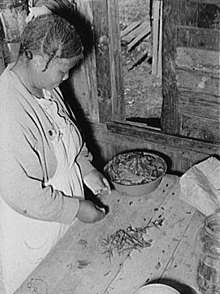 Preparing poke salad
Preparing poke salad
near Marshall, TX, c. 1930
Photo: via answers.com
Folklore tells us that pokeweed or poke salad, like early spring dandelion and chicory, was a welcome addition to a pioneers’ winter-weary salt pork diet, though one is warned to boil only the young greens from shoots no longer than six inches long, before the stems turn crimson, because the older plant has toxic properties. You must “throw off” the boiling water twice before eating. One of pokeweeds “reputed virtues” is as a cathartic—I believe I’ll leave the taste testing to my mockingbirds.
Someone once told me that during the Civil War, soldiers used the purple stain from the fruit as an ink substitute. I wonder if those pokeweed letters are still legible, or if they have faded into the ground like the plant itself after the first frost. Pokeweed’s range is so widespread, that I like to imagine hungry and lonesome soldiers happy to recognize it as they were bivouacked in temperate forests far from home.
Thursday, July 12, 2007
Flower Seed and Shutterbugs/Lady Bird Johnson
Former first lady and grandmother of Texas, Lady Bird Johnson died July 11, but not before seeding a nation with wildflowers.
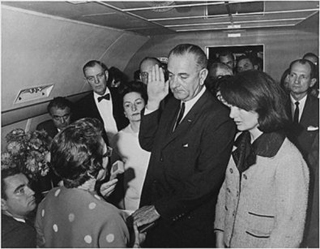
Lyndon Johnson takes the oath of Presidential Office
November 22, 1963
Photo: Cecil Stoughton
At the Lyndon Baines Johnson Library here in Austin hangs the famous picture—LBJ, one hand raised, the other on the Bible, head nearly touching the ceiling of Air Force One. To his left stands dazed and beautiful Jacqueline Kennedy, dark hair shining and falling over her eye, and to his right a squat little woman stares forward with resolve: Lady Bird. (Did anyone notice the vase of asters there?)
Mrs. Johnson died yesterday, age 94. Janet Wilson’s front page obituary for the Austin American Statesman is sumptuous. It even includes a tiny detail we thought might be left out—that there wasn’t one flower at the Johnsons’ wedding in November 1934.
Of course, Lady Bird made up for that. Her battle against the US billboard lobby and dedication to native plant conservation changed the public landscape, toning down the signage, and pouring on wildflowers. The grim picture from November 1963 is indelible as images go, but Mrs. Johnson, unlike so many in the public spotlight, managed to pursue a life beyond images. For us, a more accurate picture of her is this one, taken by Frank Wolfe in 1982. At the groundbreaking for the original Lady Bird Johnson Wildflower Center, Claudia Alta Johnson stands in a vortex of people, microphones and lenses and calmly casts out flower seed.
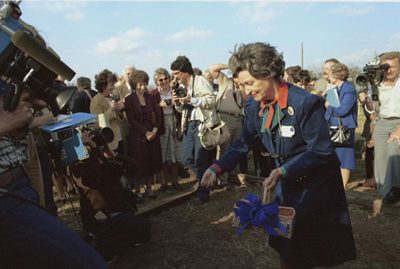
Seeding the Lady Bird Johnson Wildflower Center, 1982
Photo: Frank Wolfe, via wiki
“The environment is where we all meet; where we all have a mutual interest; it is one thing that all of us share. Whatever its condition, it is, after all, a reflection of ourselves—our tastes, our aspirations, our successes, and our failures. Fortunately, if we want to badly enough, we can do much to change what is not pleasurable to the eye and spirit. Even in the poorest neighborhoods you can find a geranium in a coffee can, a window box set against the scaling side of a tenement, a border of roses struggling to live in a tiny patch of open ground. Where flowers bloom, so does hope.”
—Lady Bird Johnson
Wednesday, July 11, 2007
Compelling: Flowers Bear a Protest to the Immigration Office
After a recent cut-off of U.S. work permits, immigrants pile on flowers faster than the federal immigration office can deflect them.

Flowers sent in protest to U.S. Immigration Services
head off to Walter Reed Army Medical Center—oops!
Photo: Xiyun Yang, for The Washington Post
Every hostess knows: when fresh flowers arrive, you take off your oven mitts, put down your wine, dropping everything to get those beauties into a clean vase of water.
An immigrant rights group representing highly skilled workers is counting on that reflex this week, as it asks supporters to send white flowers to the U.S. Citizenship and Immigration Services (USCIS) office in Washington. “The spontaneous flower protest began to take off Tuesday from information posted on a Web site based in New Jersey — www.immigrationvoice.org,” one Jersey paper reported. Actually, there was nothing “spontaneous” about it (though the delivery of fresh flowers, marvelously, has a way of seeming that way). Immigration Voice masterminded its floral demonstration after a plan to permit employer-sponsored green cards fell through July 2. The measure would have smoothed the way for high-tech workers to gain legal work status in the U.S. but the USCIS reversed itself and announced that no such applications would be taken.
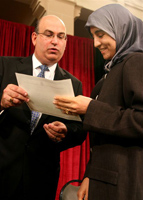 USCIS Director Emilio Gonzales greets a new citizen
USCIS Director Emilio Gonzales greets a new citizen
Sept. 2006 at an Ellis Island ceremony
Photo: USCIS
The group asked that supporters send white flowers to USCIS Director Emilio Gonzalez over three days, July 10, 11, and 12th (there’s still time!), giving clear instructions both for ordering flowers and contacting national media. Immigration Voice, unfortunately, recommended using wire services; may we suggest that you contact a real florist in the D.C area instead—here are just a few.
The floral protest may very likely have been inspired by Lage Raho Munnabhai, an Indian movie. In the film, “character Munna Bhai wins over the tough Dr. Asthana by means of chain deliveries of flower bouquets,” applying to personal conflict Mohandas Gandhi’s non-violent opposition to British rule.
“Soumendra Samal, a resident of Monroe (New Jersey) who moved to the United States in 1999, sent flowers Tuesday to the USCIS. ‘I am silently trying to protest against what’s wrong,’ he said.”
We’ve read that by noon yesterday, 200 arrangements had already arrived at the immigration services office. Director Emilio Gonzalez issued the following statement: “I understand that individuals are planning to send flowers to U.S. Citizenship and Immigration Services (USCIS) beginning on Tuesday, July 10. USCIS has made arrangements to forward those flowers to our injured service members recuperating at Walter Reed Army Medical Center and at Bethesda Naval Hospital.”
Cut flowers aren’t like angry emails. Since they’re alive (or recently were), you can’t just ignore or delete them. But Gonzalez’s re-routing the blooms to Walter Reed, however noble it first appears, is an ill-considered deflection. White flowers in much of the world (including the corner of it where we grew up) are for funerals, just what one does NOT send to someone in the hospital.
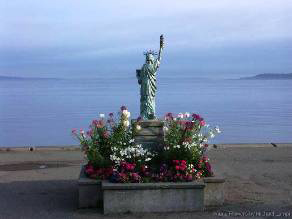 The other Statue of Liberty
The other Statue of Liberty
Aiki Beach, Seattle, WA
Photo: 360digest
Congratulations to Immigration Voice on this fine demonstration. It appears to have succeeded at least in drawing attention to the issue via some major newspapers and news wires. But in the remaining 24 hours of your protest, please direct your floral “voices” to unwire, and speak to the immigration services office through the many real florists in D.C.
USCIS
20 Massachusetts Avenue NW
Washington D.C. 20529
Phone number: 202-272-1330
And here’s the message Immigration Voice recommends:
“Kindly do not return our I-485 petitions in July and honor the original DOS visa bulletin
[ first-name last-name ] – An employment based immigrant.”
And we at Human Flower Project suggest adding: “By the way, don’t route these flowers to Walter Reed. White flowers like these are associated with mourning and are inappropriate for people convalescing.”




